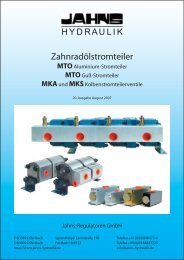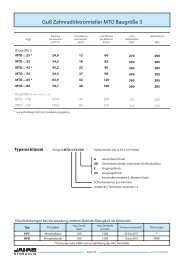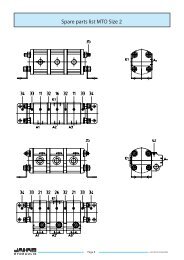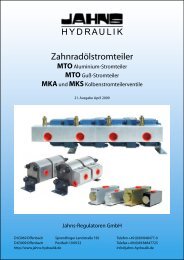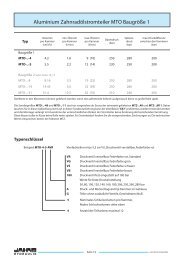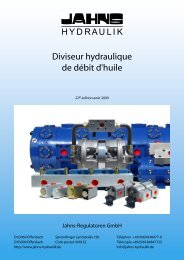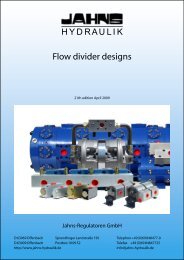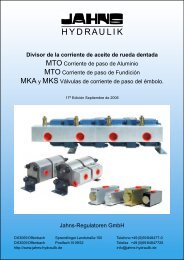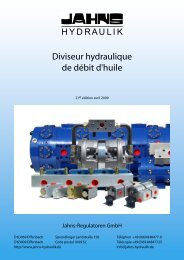You also want an ePaper? Increase the reach of your titles
YUMPU automatically turns print PDFs into web optimized ePapers that Google loves.
4. Negative brakes<br />
4.1 Negative brakes<br />
The gearboxes can be supplied with a hydraulic negative brake:<br />
- The brakes from model F01 to model F26 are for the direct mounting of orbit motors with SAE A fl anges.<br />
- The brakes from model F501 to model F 612 reach greater braking torques and are mounted with a ST entrance<br />
for the mounting of fl anges and connecting couplings for a vast range of commercially available motors.<br />
- The brake models F813 to F830 achieve braking torques up to 3.050 Nm and come with the same direct input<br />
assembly as the JPL 310/510.<br />
- The MD brake is mounted directly into a connecting fl ange for the MLG - MLR motors on the JPL 110/JPL 240<br />
gearbox.<br />
Braking is generated by springs, which compress fi xed alternating tempered steel discs against bronze mobile<br />
discs; this thrust is transformed by friction into a braking torque. Brake releasing is achieved by the injection of<br />
hydraulic pressure into the brake; the pressure acts upon a piston, which compresses the springs, thus enabling the<br />
disc to rotate freely.<br />
The brakes are therefore static and closed when hydraulic pressure is zero and they open when the hydraulic<br />
pressure reaches the opening values for release. The brakes are not lubrifi cated by the oil from the gearbox. It is<br />
necessary to carry out the fi lling (approximately 0,1 l) with mineral oil of a viscosity ISO VG32; or as an alternative it<br />
is possible to use hydraulic oils.<br />
4.2 Brake selection<br />
The following parameters must be taken into consideration:<br />
- Braking torques are calculated with the pilot pressure = 0 bar; in the case of counter-pressures in the hydraulic<br />
circuit, the effective torque values are reduced as follows:<br />
Eff. Torque = Static Torque x (Opening pressure – Counter-pressure) / Opening pressure<br />
- The brake torque must be greater or equal to that of the motor:<br />
www.jahns-<strong>hydraulik</strong>.de<br />
Tf T 1<br />
- The brake torque multiplied by the reduction ratio and divided by the output of the gearbox, must be greater or<br />
equal to output torque:<br />
Tf • ie / ηm T 2<br />
- The brake torque multiplied by the reduction ratio and divided by the gearbox effi ciency must not exceed 90% of<br />
the impulse output torque of the gearbox.:<br />
Tf • ie / ηm 0,9 T 2imp<br />
5. Assemblypositions<br />
In order to provide a complete defi nition of the constructive form of the gearbox, the assembly position must be<br />
defi ned.<br />
Based upon the position it is also possible to identify the oil fi lling, level and drain plugs. See page G.236 - G.238.<br />
Page B. 11<br />
H Y D R A U L I K



